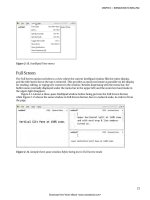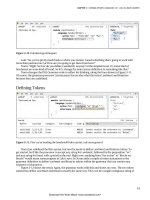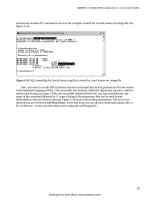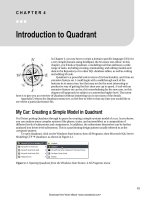Tài liệu Beginning SQL - Paul Wilton and John W. Colby pdf
Bạn đang xem bản rút gọn của tài liệu. Xem và tải ngay bản đầy đủ của tài liệu tại đây (8.94 MB, 522 trang )
Beginning SQL
Paul Wilton and John W. Colby
01_577328 ffirs.qxd 1/28/05 11:22 PM Page iii
01_577328 ffirs.qxd 1/28/05 11:22 PM Page ii
Beginning SQL
01_577328 ffirs.qxd 1/28/05 11:22 PM Page i
01_577328 ffirs.qxd 1/28/05 11:22 PM Page ii
Beginning SQL
Paul Wilton and John W. Colby
01_577328 ffirs.qxd 1/28/05 11:22 PM Page iii
Beginning SQL
Published by
Wiley Publishing, Inc.
10475 Crosspoint Boulevard
Indianapolis, IN 46256
www.wiley.com
Copyright © 2005 by Wiley Publishing, Inc., Indianapolis, Indiana
Published simultaneously in Canada
ISBN: 0-7645-7732-8
Manufactured in the United States of America
10 9 8 7 6 5 4 3 2 1
1MA/RW/QS/QV/IN
No part of this publication may be reproduced, stored in a retrieval system, or transmitted in any form or by any
means, electronic, mechanical, photocopying, recording, scanning or otherwise, except as permitted under Sections
107 or 108 of the 1976 United States Copyright Act, without either the prior written permission of the Publisher or
authorization through payment of the appropriate per-copy fee to the Copyright Clearance Center, 222 Rosewood
Drive, Danvers, MA 01923, (978) 750-8400, fax (978) 646-8600. Requests to the Publisher for permission should be
addressed to the Legal Department, Wiley Publishing, Inc., 10475 Crosspoint Blvd., Indianapolis, IN 46256, (317)
572-3447, fax (317) 572-4355, email:
.
LIMIT OF LIABILITY/DISCLAIMER OF WARRANTY: THE PUBLISHER AND THE AUTHOR MAKE NO REP-
RESENTATIONS OR WARRANTIES WITH RESPECT TO THE ACCURACY OR COMPLETENESS OF THE CON-
TENTS OF THIS WORK AND SPECIFICALLY DISCLAIM ALL WARRANTIES, INCLUDING WITHOUT
LIMITATION WARRANTIES OF FITNESS FOR A PARTICULAR PURPOSE. NO WARRANTY MAY BE CREATED
OR EXTENDED BY SALES OR PROMOTIONAL MATERIALS. THE ADVICE AND STRATEGIES CONTAINED
HEREIN MAY NOT BE SUITABLE FOR EVERY SITUATION. THIS WORK IS SOLD WITH THE UNDERSTAND-
ING THAT THE PUBLISHER IS NOT ENGAGED IN RENDERING LEGAL, ACCOUNTING, OR OTHER PRO-
FESSIONAL SERVICES. IF PROFESSIONAL ASSISTANCE IS REQUIRED, THE SERVICES OF A COMPETENT
PROFESSIONAL PERSON SHOULD BE SOUGHT. NEITHER THE PUBLISHER NOR THE AUTHOR SHALL BE
LIABLE FOR DAMAGES ARISING HEREFROM. THE FACT THAT AN ORGANIZATION OR WEB SITE IS
REFERRED TO IN THIS WORK AS A CITATION AND/OR A POTENTIAL SOURCE OF FURTHER INFORMA-
TION DOES NOT MEAN THAT THE AUTHOR OR THE PUBLISHER ENDORSES THE INFORMATION THE
ORGANIZATION OR WEB SITE MAY PROVIDE OR RECOMMENDATIONS IT MAY MAKE. FURTHER, READ-
ERS SHOULD BE AWARE THAT INTERNET WEB SITES LISTED IN THIS WORK MAY HAVE CHANGED OR
DISAPPEARED BETWEEN WHEN THIS WORK WAS WRITTEN AND WHEN IT IS READ.
For general information on our other products and services or to obtain technical support, please contact our Customer
Care Department within the U.S. at (800) 762-2974, outside the U.S. at (317) 572-3993, or fax (317) 572-4002.
Wiley also publishes its books in a variety of electronic formats. Some content that appears in print may not be
available in electronic books.
Library of Congress Cataloging-in-Publication Data
Wilton, Paul, 1969-
Beginning sql / Paul Wilton and John W. Colby.
p. cm.
Includes bibliographical references and index.
ISBN 0-7645-7732-8 (paper/website : alk. paper)
1. SQL (Computer program language) I. Colby, John W., 1954- II. Title.
QA76.73.S67W57 2005
005.75'65--dc22
2004031057
Trademarks: Wiley, the Wiley Publishing logo, Wrox, the Wrox logo, Programmer to Programmer, and related trade
dress are trademarks or registered trademarks of John Wiley & Sons, Inc., and/or its affiliates, in the United States
and other countries, and may not be used without written permission. All other trademarks are the property of their
respective owners. Wiley Publishing, Inc., is not associated with any product or vendor mentioned in this book.
01_577328 ffirs.qxd 1/28/05 11:22 PM Page iv
About the Authors
Paul Wilton
After an initial start as a Visual Basic applications programmer at the Ministry of Defense in the U.K.,
Paul found himself pulled into the Net. Having joined an Internet development company, he spent the
last three years helping create Internet solutions and is currently working on an e-commerce Web site for
a major British bank.
Paul’s main skills are in developing Web front ends using DHTML, JavaScript, VBScript, and Visual
Basic and back-end solutions with ASP, Visual Basic, and SQL Server. Currently, Paul is working on a
new Web-based application that will hopefully make him millions. . . well, thousands at least!
Paul Wilton contributed Chapters 1–9 and Appendixes A, B and C to this book.
John W. Colby
John Colby is an independent consultant who has specialized in Access development since 1994. He has
designed databases for companies in the U.S., Mexico, Canada, and Ireland. John is past president and
current board member of Database Advisors, Inc. (
www.databaseAdvisors.com
), a not-for-profit orga-
nization dedicated to providing fellow developers with a place to discuss Access, SQL Server, Visual
Basic, and other topics relative to modern database applications development. Database Advisors also
allows developers to showcase their talents by sharing databases, wizards, and various code packages.
John lives in northwestern Connecticut with his wife and two small children. He enjoys music, travel, and
all things computers, and he dreams of working from his laptop while enjoying travel with his family.
John W. Colby contributed Chapters 10–13 to this book.
01_577328 ffirs.qxd 1/28/05 11:22 PM Page v
Credits
Senior Acquisitions Editor
Jim Minatel
Development Editor
Brian Herrmann
Production Editor
Felicia Robinson
Technical Editor
Wiley-Dreamtech India Pvt Ltd
Copy Editor
Publication Services
Editorial Manager
Mary Beth Wakefield
Vice President & Executive Group Publisher
Richard Swadley
Vice President and Publisher
Joseph B. Wikert
Project Coordinator
April Farling
Graphics and Production Specialists
Lauren Goddard
Jennifer Heleine
Amanda Spagnuolo
Quality Control Technician
John Greenough
Leeann Harney
Jessica Kramer
Brian H. Walls
Proofreading and Indexing
TECHBOOKS Production Services
01_577328 ffirs.qxd 1/28/05 11:22 PM Page vi
Paul Wilton: With lots of love to my darling Beci, who, now that the book’s finished, will get
to see me for more than ten minutes a week.
John W. Colby: Dedicated to my son Robbie and my daughter Allie, who give me so much
inspiration, and to my wife Mary, a wonderful soul mate and mother.
01_577328 ffirs.qxd 1/28/05 11:22 PM Page vii
01_577328 ffirs.qxd 1/28/05 11:22 PM Page viii
Contents
About the Authors v
Acknowledgments xvii
Introduction 1
Who This Book Is For 2
What This Book Covers 2
How This Book Is Structured 2
What You Need to Use This Book 3
Conventions 4
Source Code 4
Errata 5
p2p.wrox.com 5
Chapter 1: Introduction to SQL 7
A Brief History of Databases 7
Identifying Databases 8
Why and When to Use a Database 9
Database Management Systems Used in This Book 11
Structured Query Language (SQL) 11
Introducing SQL Queries 11
Comparing SQL to Other Programming Languages 12
Understanding SQL Standards 13
Database Creation 14
Organizing a Relational Database 14
SQL Syntax 16
Creating a Database 17
Understanding Data Types 18
Creating, Altering, and Deleting Tables 25
Creating a Table 25
Altering an Existing Table 26
Deleting an Existing Table 27
Good Database Design 28
Obtaining and Analyzing Your Data Needs 28
Dividing Data Logically 29
02_577328 ftoc.qxd 1/28/05 11:21 PM Page ix
x
Contents
Selecting Correct Data Types 32
Using a Primary Key 33
Creating the Example Database 35
Summary 39
Exercises 40
Chapter 2: Entering Information 41
Inserting New Data 41
Inserting Data into the Case Study Database 45
Updating Data 45
The WHERE Clause 47
The Logical Operators AND and OR 48
Deleting Data 49
Summary 50
Exercises 51
Chapter 3: Extracting Information 53
The SELECT Statement 53
Returning Only Distinct Rows 55
Using Aliases 56
Filtering Results with the WHERE Clause 56
Logical Operators and Operator Precedence 62
Introducing Operator Precedence 62
Using Logical Operators 65
NOT Operator 66
BETWEEN Operator 66
LIKE Operator 70
IN Operator 73
Ordering Results with ORDER BY 75
Joining Columns — Concatenation 82
MS SQL Server and MS Access 82
Oracle and IBM DB2 85
MySQL 88
Selecting Data from More Than One Table 90
Using Brackets around Inner Joins in MS Access 100
SQL Is Set-Based 102
Introducing NULL Data 113
Summary 115
Exercises 116
02_577328 ftoc.qxd 1/28/05 11:21 PM Page x
xi
Contents
Chapter 4: Advanced Database Design 117
Normalization 117
First Normal Form 118
Second Normal Form 119
Third Normal Form 121
Ensuring Data Validity with Constraints 123
NOT NULL Constraint 124
UNIQUE Constraint 125
CHECK Constraint 129
Primary Key and PRIMARY KEY Constraint 132
Foreign Key 135
Speeding Up Results with Indexes 139
Improving the Design of the Film Club Database 143
Reexamining the Film Club Database Structure 143
Improving Data Validation and Efficiency 145
Tips for Designing a Better Database 153
Summary 154
Exercises 155
Chapter 5: Manipulating Data 157
Understanding SQL Arithmetic 157
Basic Math Operators 157
Common Math Functions 159
The ABS() Function 159
The POWER() Function 160
The SQRT() Function 162
The RAND() Function 162
Rounding Numbers 163
The CEILING() Function 165
The FLOOR() Function 166
The ROUND() Function 166
Introducing String Functions 168
The SUBSTRING() Function 168
Case Conversion Functions 170
The REVERSE() Function 171
The TRIM() Functions 172
The LENGTH() Function 172
The SOUNDEX() and DIFFERENCE() Functions 175
Date Functions 178
Converting Different Data Types 179
02_577328 ftoc.qxd 1/28/05 11:21 PM Page xi
xii
Contents
Re-examining NULL 180
NULLs and Math 180
NULLs and Strings 182
The COALESCE() Function 183
Using INSERT INTO with the SELECT Statement 185
Summary 187
Exercises 188
Chapter 6: Grouping and Aggregating Data 189
Grouping Results 189
Summarizing and Aggregating Data 191
Counting Results 192
Adding Results 196
Averaging Results 198
MAX() and MIN() in Results 200
Using the HAVING Clause with GROUP BY Statements 202
Summary 205
Exercises 205
Chapter 7: Selecting Data from Different Tables 207
Joins Revisited 207
Inner Joins: An In-Depth Look 208
Equijoins and Non-equijoins 208
Multiple Joins and Multiple Conditions 210
Cross Joins 213
Self-Joins 214
Outer Joins 218
Left Outer Join 219
Right Outer Join 221
Full Outer Join 225
Combining Results Sets with the UNION Operator 226
Summary 233
Exercises 233
Chapter 8: Queries within Queries 235
Subquery Terminology 235
Subqueries in a SELECT List 236
Subqueries in the WHERE Clause 240
02_577328 ftoc.qxd 1/28/05 11:21 PM Page xii
xiii
Contents
Operators in Subqueries 242
Revisiting the IN Operator 242
Using the ANY, SOME, and ALL Operators 245
ANY and SOME Operators 245
ALL Operator 247
Using the EXISTS Operator 249
Using the HAVING Clause with Subqueries 252
Correlated Subquery 253
Subqueries Used with Other Statements 255
Using Subqueries with the INSERT Statement 255
Using Subqueries with the UPDATE Statement 257
Using Subqueries with the DELETE FROM Statement 259
Summary 261
Exercises 261
Chapter 9: Advanced Queries 263
Updating the Database 263
Tackling Difficult Queries 270
Work Out What You Want, What You Really, Really Want 270
Choosing the SELECT Column List 271
Creating the FROM Clause 271
Top Tips for Efficient Queries 283
Summary 285
Exercises 286
Chapter 10: Views 287
Introducing Views 287
Creating Views 288
Types of Views 290
Table Join Views 290
Base View 290
Row Views 291
Field Views 292
Filtered Windowed Views 292
Summary Views 293
Updating Views 294
Update Restrictions 295
Check Option 295
Dropping Views 298
Summary 299
Exercises 299
02_577328 ftoc.qxd 1/28/05 11:21 PM Page xiii
xiv
Contents
Chapter 11: Transactions 301
Introducing Transactions 302
Example Data 303
ANSI Model 305
COMMIT 306
ROLLBACK 307
Transact-SQL 308
BEGIN TRANSACTION 308
COMMIT TRANSACTION 308
SAVE TRANSACTION 309
ROLLBACK TRANSACTION 310
Transaction Logs 312
Locks 313
Locking Granularity 313
Database 314
Table 314
Page 314
Row 314
Column 314
Locking Levels 314
Shared 315
Exclusive 315
Deadlocks 315
Setting Lock Parameters 316
Lock Size 316
Number of Locks 316
Escalation 316
Timeout 317
Isolation Levels 318
SET TRANSACTION 318
SERIALIZABLE 318
REPEATABLE READ 319
READ COMMITTED 319
READ UNCOMMITTED 319
Versioning 320
Problem Examples 320
The Lost Update 320
The Uncommitted Data 321
The Inconsistent Data 321
The Phantom Insert 322
Revisiting the Example Code 322
Summary 325
Exercises 325
02_577328 ftoc.qxd 1/28/05 11:21 PM Page xiv
xv
Contents
Chapter 12: SQL Security 327
Security Concepts 327
User IDs 329
Creating User IDs 330
Alter User 330
Drop User 331
Group IDs (Roles) 332
Objects 335
Privileges 336
Extended Privileges 336
The USAGE Privilege 337
Ownership 337
Views and Security 337
Vertical and Horizontal Views 337
Grouped Views 340
Limitations on Views 341
Granting Privileges 341
Tables and Views 341
Columns 342
The GRANT OPTION Clause 343
Revoking Privileges 344
The REVOKE Statement 344
Revoking GRANT 345
The CASCADE and RESTRICT Options 346
Summary 348
Exercises 348
Chapter 13: Database Tuning 349
Tuning Hardware 349
Workstations 350
Database Files 351
Processors 351
Gigahertz Networks or Compartmentalized Networks 352
Caches 352
Processor Cache 352
Hard Disk Cache 352
Database Cache 354
Tuning SQL 355
What Does SQL Tuning Mean? 355
Why Do You Do It? 356
02_577328 ftoc.qxd 1/28/05 11:21 PM Page xv
xvi
Contents
How Do You Do It? 357
Indexes — What Are They? 357
Indexes — When They Help, Hurt, or Don’t Matter 360
Table Scans — What Are They? 361
When Table Scans Help, Hurt, or Don’t Matter 362
Tuning Tips 363
Summary 364
Exercises 365
Appendix A: Exercise Answers 367
Appendix B: Setting Up and Using the Five Database Systems 391
Appendix C: Initial Data Setup 451
Index 475
02_577328 ftoc.qxd 1/28/05 11:21 PM Page xvi
xvii
Acknowledgments
Paul Wilton
Many thanks to Catherine who for many years supported me and ensured that my sanity chip remained
plugged in. I’d also like to thank Brian Herrmann, who has been a great editor to work with and has
done amazing work on the book and kept his professionalism and sense of humor even when faced with
another of my “just a few more days and I’ll get the chapter to you” emails! Thanks also to Jim Minatel
for allowing me to subject the world to yet another of my books. Finally, pats and treats to my German
shepherd Katie, who does an excellent job in warding off disturbances from door-to-door salespeople.
03_577328 flast.qxd 1/28/05 11:22 PM Page xvii
03_577328 flast.qxd 1/28/05 11:22 PM Page xviii
Introduction
Data, data, data! Data is where it’s at as far as computers go, whether processing millions of calcu-
lations or keeping a record of your Aunt Maude’s birthday. When it comes to storing data, the
database is the king. In almost eight years of professional programming, every single project I’ve
worked on has involved databases somewhere along the line — that’s how essential they are to
most business applications and projects. Admittedly, some areas, such as computer games, don’t
make the same use of databases. My guess is that “Mega Doom 99: The Final Bloody Massacre”
isn’t running an Oracle database in the background!
However, I have a confession! Around 10 years ago, when I first started learning about databases,
I initially found them very confusing. I’d been programming in my spare time for a few years
and was used to using text files to store information. I decided to leap right in and start creating
databases and writing SQL, and I got very confused and odd results. Databases, their design, and
their underlying concepts are very different from storing data in simple files, and the Structured
Query Language (SQL) used to access and manipulate data in databases is very different from any
procedural language. One of my first aims with this book is to soften the blow of new concepts
and ways of doing things. To that end, I explain all the underlying concepts and theory you’ll need
to get started with databases and in programming with SQL. How to get the answers you want
from a database and all the results you get will be fully explained, as SQL can throw up some sur-
prises if you’re not forewarned.
Another of my aims in writing this book is to get you quickly and effectively to the point where
you’re able to go off on your own and design your own databases and write your own SQL code
in a practical environment. Personally, I dislike books that waffle on about every small detail and
eventuality so that it takes months to be able to stand on your own feet and create your own work.
I stick with the stuff that you’ll find is used in most database applications, keeping the fine details
and more advanced stuff for the later chapters. The first few chapters’ aim is to get you up and
running in SQL quickly, but they do not skimp on essential concepts, code, and techniques, which
are all thoroughly discussed and backed up with lots of practical examples.
Finally, I’m a hands-on, practical person, and those are the sort of computer books I like to read,
rather than books that contain lots of theory. This book reflects my “put it into action” nature and
is full of examples and places where you can get hands-on experience. I do introduce and explain
theory where it’s necessary to build a foundation of understanding, but I do this only with the
04_577328 intro.qxd 1/28/05 11:23 PM Page 1
eventual aim of putting theory into practice. I use databases and SQL most days in my programming,
and I hope to bring that real-world experience to this book.
Who This Book Is For
This book starts right from the basics with databases and SQL. Prior database or SQL knowledge is not
necessary, as this book covers everything from database design to creating your first database and
understanding how the SQL language is used with databases.
If you have some previous experience with databases and SQL, then you’ll have a head start and you
may want to just skim Chapter 1. You’ll need to follow its instructions for creating the book’s example
database, as this is used for all the examples throughout the book.
What This Book Covers
This book will look at Structured Query Language, or SQL as it’s usually abbreviated. SQL works with a
database to create the database and to insert and extract data. Therefore, it’s essential to understand the
theory and concepts behind database systems. Hence, this book also covers database theory and
database design, so that you’re equipped to create an effective database.
The SQL code in this book reflects the modern SQL standards set by organizations such as the American
National Standards Institute (ANSI) and the International Standards Organization (ISO). However,
while standards are great, what’s available for practical use is what really counts. This book, then, con-
centrates on the sort of SQL supported by most modern database systems. You should that find most of
the code runs with little or no modification on most database systems released within the last six or
seven years.
How This Book Is Structured
This book has been split into two main parts. The first part, which consists of Chapters 1–3, provides the
foundations for understanding databases and SQL. The aim in this first part is to get you up to speed on
all the essential details. These chapters take you through the following:
❑ The essentials of database theory
❑ Writing SQL code
❑ Good database design
❑ Creating a database
❑ Entering, updating, and deleting data using SQL
❑ Extracting data using SQL — more specifically, how to answer the sort of questions often posed
of databases in real-life situations
2
Introduction
04_577328 intro.qxd 1/28/05 11:23 PM Page 2
By the time you’ve completed Chapter 3, you’ll be ready to go out and create your own databases and
write your own SQL code to a sufficient standard for many real-life programming situations. You may
want to go and create a few databases of your own before returning to the second part of the book.
The second half of the book, Chapters 4 onward, goes into more detail and looks at more advanced top-
ics. Its aim is to provide a fairly wide and thorough grounding in many aspects of SQL programming.
The sort of topics covered include the following:
❑ Advanced database design, taking a look at the theory and practical application of normaliza-
tion, and how to improve a database’s efficiency and reliability
❑ Using and manipulating data with SQL’s built-in data manipulation and calculation functions
❑ Selecting data from lots of different tables
❑ Database security
❑ Database optimization
The book also includes three appendixes. Appendix A contains the answers to the exercise questions in
each chapter, so no peeking until you’ve given the questions a go. Appendix B covers how to download,
install, and use each of the five supported database systems used by this book. Appendix C includes the
initial data for the example database, which is available to download from
www.wrox.com
if you want to
avoid aching fingers!
What You Need to Use This Book
To really make use of this book and run the examples, you need to have a database system on which to
practice. This book’s code has been thoroughly tested on the following five commonly available
database systems:
❑ MySQL
❑ Microsoft SQL Server
❑ IBM DB2
❑ Microsoft Access
❑ Oracle 10g
The good news is that almost all of those can be downloaded free off the Internet as full or trial versions.
In Appendix B, you’ll learn where to download them, how to install them, and how to use them.
It’s not a problem if you’re using a different database system, because as often as possible, I’ve avoided
database system-specific code and have kept to standard SQL supported by most database systems.
Where it’s impossible to have the same code for all the database systems, I’ve listed the ways around as
well as alternative syntax. You’ll likely find that one of the variations of syntax will work on your sys-
tem, possibly with a little modification.
3
Introduction
04_577328 intro.qxd 1/28/05 11:23 PM Page 3
Conventions
To help you get the most from the text and keep track of what’s happening, this book uses a number of
conventions throughout.
Try It Out
The Try It Out is an exercise that you should work through, following the text in the book.
1.
They usually consist of a set of steps.
2.
Each step has a number.
3.
Follow the steps through with your copy of the database.
How It Works
After each Try It Out, the code you’ve typed will be explained in detail.
Tips, hints, tricks, and asides to the current discussion are offset and placed in italics like this.
As for styles in the text:
❑ New terms and important words are italicized as they are introduced.
❑ Keyboard strokes are shown like this: Ctrl+A.
❑ Filenames, URLs, and code within the text are shown like so:
persistence.properties
.
❑ Code is presented in two different ways:
In code examples, new and important code is highlighted with a gray background.
The gray highlighting is not used for code that’s less important in the present
context or that has been shown before.
Source Code
As you work through the examples in this book, you may choose either to type in all the code manually
or to use the source code files that accompany the book. All of the source code used in this book is avail-
able for download at
. Once at the site, simply locate the book’s title (either by
using the Search box or by using one of the title lists) and click the Download Code link on the book’s
detail page to obtain all the source code for the book.
Because many books have similar titles, you may find it easiest to search by ISBN; for this book, the
ISBN is 0-7645-7732-8.
Boxes like this one hold important, not-to-be-forgotten information that is directly
relevant to the surrounding text.
4
Introduction
04_577328 intro.qxd 1/28/05 11:23 PM Page 4









